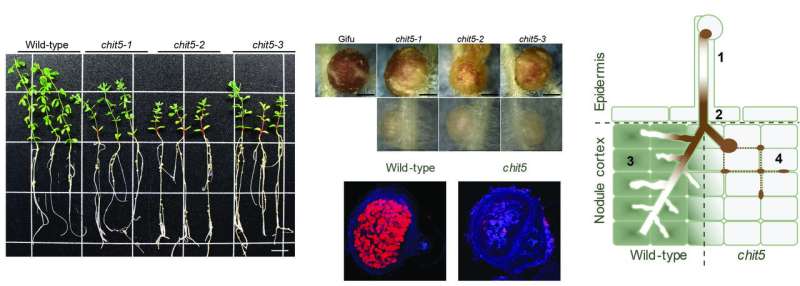The Goldilocks principle in biology—fine-tuning the 'just right' signal load

In the fairy tale "Goldilocks and the Three Bears," Goldilocks invades the bears' house, where she finds three bowls of porridge, but only one has just the right temperature. Similarly, in biological processes, there often exist "just right" conditions—this is called the Goldilocks principle. This is what an international research team has done by demonstrating that in order to get the right amount of signaling for symbiosis in the roots of legumes, a specific enzyme called chitinase (CHIT5) must be present.
Legumes have evolved the ability to host nitrogen-fixing bacteria within special organs in their roots. This interaction is dependent on plant recognition of a bacterial Nod factor signal molecule. The bacteria provide the plant host with reduced nitrogen in the form of ammonia, and the plants can therefore grow without chemical nitrogen fertilizer. The researchers wanted to transfer this symbiotic process to other types of plants.
More specifically, in their new studies, the researchers found that the chitinase CHIT5 present in legume roots is required for Nod factor hydrolysis and functional symbiosis. Their work reveals a new and crucial role of the legume host in modulating levels of specific rhizobial Nod factor morphogens during cortical infection to ensure functional symbiosis.
Morphogens are key signals for organized development in multicellular organisms. The crucial role of self-produced morphogens like retinoic acid or transformation growth factor-beta during embryo development has been long demonstrated. Molecules of microbial nature have also been shown to induce a morphogenetic response in symbiotic eukaryotic hosts, and recently gained an increased attention via microbiome studies. The nitrogen-fixing root nodules are lateral organs induced by a microbial morphogen. In their new studies, the researchers reveal for the first time that a developmental switch in the legume plant is ensured by the host-controlled modulation of microbial morphogen, Nod factor.
Deepening our understanding of Nod factor signalling
Nod factors have been known for decades as signalling molecules produced by rhizobia to trigger and enable dinitrogen-fixing symbiosis. In addition to their signalling capacity, Nod factors have been considered morphogens based on their effect on host developmental programmes; nodule organogenesis and infection thread formation. The researchers have found that the model legume Lotus japonicus modulates the levels of the Nod factor morphogen via CHIT5 to control colonisation of nodule primordia.
Chit5 mutants display an unbalanced symbiotic signalling reminiscent of what is seen in developmental arrest at an early primordia stage. The researchers believe that their work provides the basis for a novel layer of symbiosis research, enabling a deeper understanding of Nod factor signalling during cortical infection with direct consequences for the switch to nitrogen-fixing status. This knowledge becomes especially essential in the context of the research group's current ambitious engineering projects aiming at transferring the nitrogen fixation ability to non-legumes, which could potentially have great agricultural importance.
The results have been published in the international journal eLife.
More information: Anna Malolepszy et al, A plant chitinase controls cortical infection thread progression and nitrogen-fixing symbiosis, eLife (2018). DOI: 10.7554/eLife.38874
Journal information: eLife
Provided by Aarhus University




















